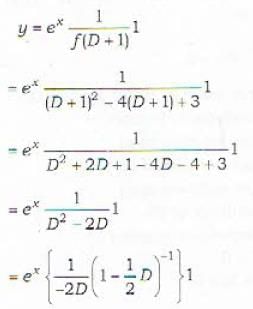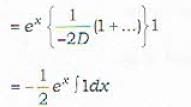Mathematics Exam > Mathematics Questions > Consider the differential equation f(D)y = ea...
Start Learning for Free
Consider the differential equation f(D)y = eax where f(a) = 0 and f(D) = 0 is the corresponding auxiliary equation, then
- a)A particular integral may or may not be obtained
- b)No particular integral can be obtained
- c)A particular integral can always be obtained
- d)None of the above is true in this case
Correct answer is option 'C'. Can you explain this answer?
| FREE This question is part of | Download PDF Attempt this Test |
Verified Answer
Consider the differential equation f(D)y = eaxwhere f(a) = 0 and f(D) ...
The given differential equation is
f(D)y = eax .......(i)
Case I : If f(a) ≠ 0, then a particular solution is given by

[Here D is replaced by a]
Case II : If f(a) = 0, then a particular solution is given by

We illustrate this with the help of following example.
Ex. : Find a particular solution of the differential equation.

and a = 1
so that f(a) = f(1) = 1 - 4 + 3 = 0
∴ A particular solution is given by


 .....(ii)
.....(ii)

Conclusion : It follows that if f(a) = 0, a particular solution will always exist.
f(D)y = eax .......(i)
Case I : If f(a) ≠ 0, then a particular solution is given by

[Here D is replaced by a]
Case II : If f(a) = 0, then a particular solution is given by

We illustrate this with the help of following example.
Ex. : Find a particular solution of the differential equation.

and a = 1
so that f(a) = f(1) = 1 - 4 + 3 = 0
∴ A particular solution is given by


 .....(ii)
.....(ii)
Conclusion : It follows that if f(a) = 0, a particular solution will always exist.
Most Upvoted Answer
Consider the differential equation f(D)y = eaxwhere f(a) = 0 and f(D) ...
Explanation:
The given differential equation is f(D)y = eax, where f(D) is a linear differential operator and f(a) = 0 is the corresponding auxiliary equation.
To find a particular integral, we need to find a function y that satisfies the given differential equation.
Let's consider the auxiliary equation f(D) = 0. The solutions of this equation are the characteristic roots of the differential equation.
Since f(a) = 0, a is a root of the auxiliary equation. Let's denote the other roots as r1, r2, ..., rn.
Particular Integral:
A particular integral can be obtained if the exponential function eax is not a solution of the auxiliary equation. This happens when a is not a root of the auxiliary equation.
If a is not a root of the auxiliary equation, then the particular integral can be obtained by assuming a particular form for y, such as y = Aeax, where A is a constant.
Substituting this assumed form of y into the given differential equation, we get:
f(D)(Aeax) = Aeax
The left-hand side of the equation can be simplified using the linearity property of the differential operator f(D):
A(f(D)eax) = A(aeax)
Since f(D)eax = aeax, we have:
A(aeax) = Aeax
The exponential terms on both sides of the equation cancel out, leaving:
Aa = A
Since A is a constant, we can divide both sides of the equation by A to get:
a = 1
So, in this case, the particular integral is y = Aeax.
Conclusion:
From the above explanation, it is clear that a particular integral can always be obtained if the exponential function eax is not a solution of the auxiliary equation. Therefore, the correct answer is option 'C' - A particular integral can always be obtained.
The given differential equation is f(D)y = eax, where f(D) is a linear differential operator and f(a) = 0 is the corresponding auxiliary equation.
To find a particular integral, we need to find a function y that satisfies the given differential equation.
Let's consider the auxiliary equation f(D) = 0. The solutions of this equation are the characteristic roots of the differential equation.
Since f(a) = 0, a is a root of the auxiliary equation. Let's denote the other roots as r1, r2, ..., rn.
Particular Integral:
A particular integral can be obtained if the exponential function eax is not a solution of the auxiliary equation. This happens when a is not a root of the auxiliary equation.
If a is not a root of the auxiliary equation, then the particular integral can be obtained by assuming a particular form for y, such as y = Aeax, where A is a constant.
Substituting this assumed form of y into the given differential equation, we get:
f(D)(Aeax) = Aeax
The left-hand side of the equation can be simplified using the linearity property of the differential operator f(D):
A(f(D)eax) = A(aeax)
Since f(D)eax = aeax, we have:
A(aeax) = Aeax
The exponential terms on both sides of the equation cancel out, leaving:
Aa = A
Since A is a constant, we can divide both sides of the equation by A to get:
a = 1
So, in this case, the particular integral is y = Aeax.
Conclusion:
From the above explanation, it is clear that a particular integral can always be obtained if the exponential function eax is not a solution of the auxiliary equation. Therefore, the correct answer is option 'C' - A particular integral can always be obtained.

|
Explore Courses for Mathematics exam
|

|
Similar Mathematics Doubts
Consider the differential equation f(D)y = eaxwhere f(a) = 0 and f(D) = 0 is the corresponding auxiliary equation, thena)A particular integral may or may not be obtainedb)No particular integral can be obtainedc)A particular integral can always be obtainedd)None of the above is true in this caseCorrect answer is option 'C'. Can you explain this answer?
Question Description
Consider the differential equation f(D)y = eaxwhere f(a) = 0 and f(D) = 0 is the corresponding auxiliary equation, thena)A particular integral may or may not be obtainedb)No particular integral can be obtainedc)A particular integral can always be obtainedd)None of the above is true in this caseCorrect answer is option 'C'. Can you explain this answer? for Mathematics 2024 is part of Mathematics preparation. The Question and answers have been prepared according to the Mathematics exam syllabus. Information about Consider the differential equation f(D)y = eaxwhere f(a) = 0 and f(D) = 0 is the corresponding auxiliary equation, thena)A particular integral may or may not be obtainedb)No particular integral can be obtainedc)A particular integral can always be obtainedd)None of the above is true in this caseCorrect answer is option 'C'. Can you explain this answer? covers all topics & solutions for Mathematics 2024 Exam. Find important definitions, questions, meanings, examples, exercises and tests below for Consider the differential equation f(D)y = eaxwhere f(a) = 0 and f(D) = 0 is the corresponding auxiliary equation, thena)A particular integral may or may not be obtainedb)No particular integral can be obtainedc)A particular integral can always be obtainedd)None of the above is true in this caseCorrect answer is option 'C'. Can you explain this answer?.
Consider the differential equation f(D)y = eaxwhere f(a) = 0 and f(D) = 0 is the corresponding auxiliary equation, thena)A particular integral may or may not be obtainedb)No particular integral can be obtainedc)A particular integral can always be obtainedd)None of the above is true in this caseCorrect answer is option 'C'. Can you explain this answer? for Mathematics 2024 is part of Mathematics preparation. The Question and answers have been prepared according to the Mathematics exam syllabus. Information about Consider the differential equation f(D)y = eaxwhere f(a) = 0 and f(D) = 0 is the corresponding auxiliary equation, thena)A particular integral may or may not be obtainedb)No particular integral can be obtainedc)A particular integral can always be obtainedd)None of the above is true in this caseCorrect answer is option 'C'. Can you explain this answer? covers all topics & solutions for Mathematics 2024 Exam. Find important definitions, questions, meanings, examples, exercises and tests below for Consider the differential equation f(D)y = eaxwhere f(a) = 0 and f(D) = 0 is the corresponding auxiliary equation, thena)A particular integral may or may not be obtainedb)No particular integral can be obtainedc)A particular integral can always be obtainedd)None of the above is true in this caseCorrect answer is option 'C'. Can you explain this answer?.
Solutions for Consider the differential equation f(D)y = eaxwhere f(a) = 0 and f(D) = 0 is the corresponding auxiliary equation, thena)A particular integral may or may not be obtainedb)No particular integral can be obtainedc)A particular integral can always be obtainedd)None of the above is true in this caseCorrect answer is option 'C'. Can you explain this answer? in English & in Hindi are available as part of our courses for Mathematics.
Download more important topics, notes, lectures and mock test series for Mathematics Exam by signing up for free.
Here you can find the meaning of Consider the differential equation f(D)y = eaxwhere f(a) = 0 and f(D) = 0 is the corresponding auxiliary equation, thena)A particular integral may or may not be obtainedb)No particular integral can be obtainedc)A particular integral can always be obtainedd)None of the above is true in this caseCorrect answer is option 'C'. Can you explain this answer? defined & explained in the simplest way possible. Besides giving the explanation of
Consider the differential equation f(D)y = eaxwhere f(a) = 0 and f(D) = 0 is the corresponding auxiliary equation, thena)A particular integral may or may not be obtainedb)No particular integral can be obtainedc)A particular integral can always be obtainedd)None of the above is true in this caseCorrect answer is option 'C'. Can you explain this answer?, a detailed solution for Consider the differential equation f(D)y = eaxwhere f(a) = 0 and f(D) = 0 is the corresponding auxiliary equation, thena)A particular integral may or may not be obtainedb)No particular integral can be obtainedc)A particular integral can always be obtainedd)None of the above is true in this caseCorrect answer is option 'C'. Can you explain this answer? has been provided alongside types of Consider the differential equation f(D)y = eaxwhere f(a) = 0 and f(D) = 0 is the corresponding auxiliary equation, thena)A particular integral may or may not be obtainedb)No particular integral can be obtainedc)A particular integral can always be obtainedd)None of the above is true in this caseCorrect answer is option 'C'. Can you explain this answer? theory, EduRev gives you an
ample number of questions to practice Consider the differential equation f(D)y = eaxwhere f(a) = 0 and f(D) = 0 is the corresponding auxiliary equation, thena)A particular integral may or may not be obtainedb)No particular integral can be obtainedc)A particular integral can always be obtainedd)None of the above is true in this caseCorrect answer is option 'C'. Can you explain this answer? tests, examples and also practice Mathematics tests.

|
Explore Courses for Mathematics exam
|

|
Suggested Free Tests
Signup for Free!
Signup to see your scores go up within 7 days! Learn & Practice with 1000+ FREE Notes, Videos & Tests.


















